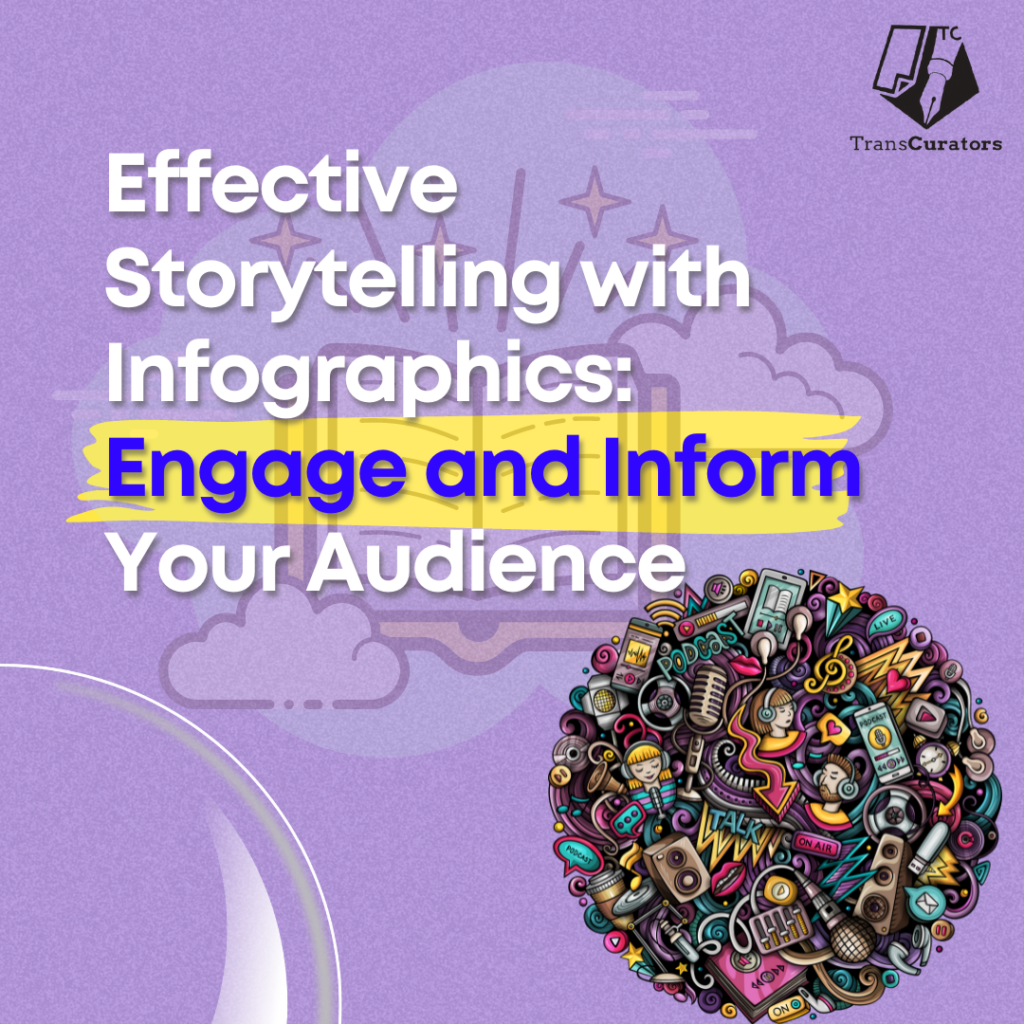Introduction
Are you looking for a more enhanced and better way to engage your audience? In today’s fast-paced digital world, effective storytelling is key to capturing and retaining your audience’s attention. And when it comes to engaging and informing your audience, infographics have emerged as a powerful tool. Combining the art of visual design with the science of data communication, infographics have the unique ability to convey complex information in a visually compelling and easily digestible format. Let’s further understand how to engage and inform your audience with infographic designs.
Engaging the Audience with the Right Visuals
Let’s explore the strategies and techniques for effective storytelling with infographics, enabling you to captivate your audience and make a lasting impact. Listed below are a few uses of infographics to engage your audience.
Merging Data and Narrative: Weaving a Coherent Storyline
Infographics excel at presenting data in a visually appealing and accessible manner. However, to truly engage your audience, it is crucial to go beyond mere data representation and weave a coherent storyline. Start by identifying the main message or key insights you want to convey through your infographic design. Then, carefully select the most relevant and impactful data points that support your narrative. Think of your infographic as a visual journey and video storytelling, wherein each section or element builds upon the previous one, creating a logical and compelling flow.
Consider using storytelling techniques such as introducing a problem or conflict, presenting supporting evidence, and offering a resolution or call to action. Use visual cues like arrows, lines, or flowcharts to guide the viewer’s eye and emphasize the connections between different data points. By creating a clear narrative structure, you assure that your audience can easily follow and understand the information you’re presenting, ultimately leaving a lasting impression.
Evoking Emotions: Creating an Emotional Connection
While data and facts are essential components of infographics, their true power lies in their ability to evoke emotions. The purpose of infographics is to go beyond presenting information and can touch the hearts and minds of your audience. To create an emotional connection, consider incorporating relevant visuals that arouse specific emotions or reactions. For example, use images of people expressing emotions, symbols, or metaphors that resonate with your message.
Color choice also plays a vital role in evoking emotions. Warm colors like red and orange can evoke excitement or urgency, while cool tones like blue and green can create a sense of calm or trust. Additionally, typography can convey tone and personality. Experiment with fonts that align with your message, whether it’s bold and authoritative or playful and friendly. By strategically integrating visuals, colors, and typography, you can create an emotional landscape within your infographic design, ensuring a deeper connection with your audience.
Prioritizing Visual Aesthetics: Creating an Artful Narrative
In the world of infographics, aesthetics are paramount. Visual design elements can greatly enhance the storytelling experience and make your infographic design visually appealing and memorable. Start by establishing a consistent visual identity, incorporating your brand colors, logo, and any relevant design elements. This ensures that your infographic aligns with your overall brand message and creates a cohesive visual experience.
Pay attention to the overall composition and layout of your infographic. Utilize white space effectively to allow your content to breathe and create a sense of balance. Select fonts that are legible and visually pleasing, using variations in size and weight to highlight key points or headings. Experiment with illustrations, icons, and other graphical elements to add visual interest and reinforce your message.
Remember, simplicity is key. Avoid cluttering your infographic with excessive information or overly complex visuals. Focus on the essential elements that drive your narrative and ensure they take centre stage. By prioritizing visual aesthetics, you create an artful narrative that captures your audience’s attention, enhances information retention, and reflects the professionalism and creativity of your brand.
Maintaining a Clear and Concise Narrative Structure
A clear and concise narrative structure is crucial for effective storytelling with infographics. Infographics should guide the viewer through a logical flow, presenting information in a way that is easy to follow and comprehend. Visual hierarchies, storytelling frameworks such as the hero’s journey or problem-solution structure, and strategically placed key points and takeaways help structure your infographic narrative effectively. This allows your audience to connect the dots and grasp the main message effortlessly.
Embracing Interactivity
Engaging the Audience Interactivity is an increasingly popular element in storytelling with infographics. By incorporating interactive elements such as clickable hotspots, animations, or scroll-triggered effects, you invite your audience to actively engage with your content. This not only enhances the user experience but also allows for personalized exploration and a deeper understanding of the information presented. Interactivity adds an extra layer of engagement, transforming your infographic into an immersive and memorable experience.
Conclusion
Compelling storytelling with infographics goes beyond data representation. You can engage and inform your audience powerfully and memorably by merging data and narrative, evoking emotions, maintaining a clear structure, and prioritizing visual aesthetics. Infographics offer a versatile and impactful platform to convey complex information, enabling you to captivate your audience and leave a lasting impression. So, unleash your creativity, experiment with Transcurators design elements, and harness the full potential of infographic designs to tell your story with impact and inspire action.
